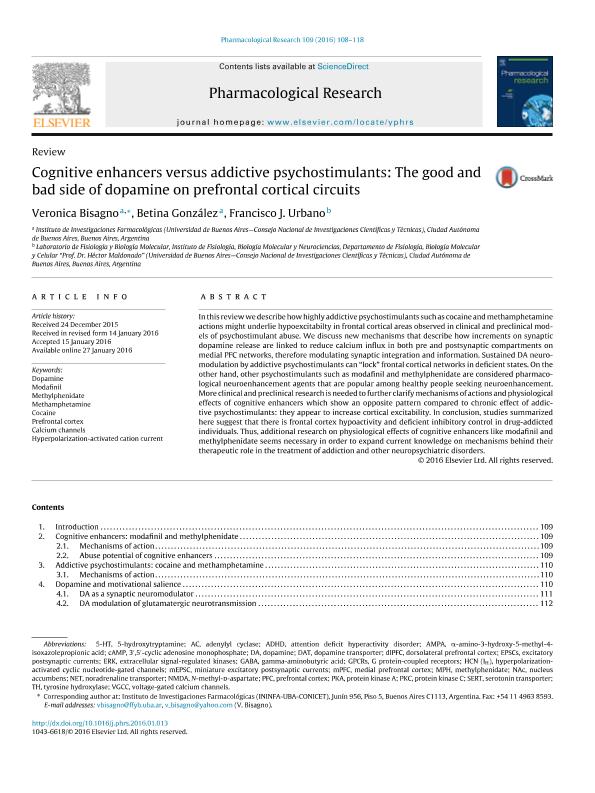Mostrar el registro sencillo del ítem
dc.contributor.author
Bisagno, Veronica

dc.contributor.author
Gonzalez, Betina

dc.contributor.author
Urbano Suarez, Francisco Jose

dc.date.available
2018-04-03T18:49:52Z
dc.date.issued
2016-07
dc.identifier.citation
Bisagno, Veronica; Gonzalez, Betina; Urbano Suarez, Francisco Jose; Cognitive enhancers versus addictive psychostimulants: The good and bad side of dopamine on prefrontal cortical circuits; Academic Press Ltd - Elsevier Science Ltd; Pharmacological Research; 109; 7-2016; 108-118
dc.identifier.issn
1043-6618
dc.identifier.uri
http://hdl.handle.net/11336/40530
dc.description.abstract
In this review we describe how highly addictive psychostimulants such as cocaine and methamphetamineactions might underlie hypoexcitabilty in frontal cortical areas observed in clinical and preclinical modelsof psychostimulant abuse. We discuss new mechanisms that describe how increments on synapticdopamine release are linked to reduce calcium influx in both pre and postsynaptic compartments onmedial PFC networks, therefore modulating synaptic integration and information. Sustained DA neuromodulationby addictive psychostimulants can ?lock? frontal cortical networks in deficient states. On theother hand, other psychostimulants such as modafinil and methylphenidate are considered pharmacologicalneuroenhancement agents that are popular among healthy people seeking neuroenhancement.More clinical and preclinical research is needed to further clarify mechanisms of actions and physiologicaleffects of cognitive enhancers which show an opposite pattern compared to chronic effect of addictivepsychostimulants: they appear to increase cortical excitability. In conclusion, studies summarizedhere suggest that there is frontal cortex hypoactivity and deficient inhibitory control in drug-addictedindividuals. Thus, additional research on physiological effects of cognitive enhancers like modafinil andmethylphenidate seems necessary in order to expand current knowledge on mechanisms behind theirtherapeutic role in the treatment of addiction and other neuropsychiatric disorders.
dc.format
application/pdf
dc.language.iso
eng
dc.publisher
Academic Press Ltd - Elsevier Science Ltd

dc.rights
info:eu-repo/semantics/openAccess
dc.rights.uri
https://creativecommons.org/licenses/by-nc-nd/2.5/ar/
dc.subject
Dopamine
dc.subject
Modafinil
dc.subject
Methylphenidate
dc.subject
Methamphetamine
dc.subject.classification
Farmacología y Farmacia

dc.subject.classification
Medicina Básica

dc.subject.classification
CIENCIAS MÉDICAS Y DE LA SALUD

dc.title
Cognitive enhancers versus addictive psychostimulants: The good and bad side of dopamine on prefrontal cortical circuits
dc.type
info:eu-repo/semantics/article
dc.type
info:ar-repo/semantics/artículo
dc.type
info:eu-repo/semantics/publishedVersion
dc.date.updated
2018-03-28T14:11:39Z
dc.journal.volume
109
dc.journal.pagination
108-118
dc.journal.pais
Estados Unidos

dc.description.fil
Fil: Bisagno, Veronica. Consejo Nacional de Investigaciones Científicas y Técnicas. Oficina de Coordinación Administrativa Houssay. Instituto de Investigaciones Farmacológicas. Universidad de Buenos Aires. Facultad de Farmacia y Bioquímica. Instituto de Investigaciones Farmacológicas; Argentina
dc.description.fil
Fil: Gonzalez, Betina. Consejo Nacional de Investigaciones Científicas y Técnicas. Oficina de Coordinación Administrativa Houssay. Instituto de Investigaciones Farmacológicas. Universidad de Buenos Aires. Facultad de Farmacia y Bioquímica. Instituto de Investigaciones Farmacológicas; Argentina
dc.description.fil
Fil: Urbano Suarez, Francisco Jose. Consejo Nacional de Investigaciones Científicas y Técnicas. Oficina de Coordinación Administrativa Ciudad Universitaria. Instituto de Fisiología, Biología Molecular y Neurociencias. Universidad de Buenos Aires. Facultad de Ciencias Exactas y Naturales. Instituto de Fisiología, Biología Molecular y Neurociencias; Argentina
dc.journal.title
Pharmacological Research

dc.relation.alternativeid
info:eu-repo/semantics/altIdentifier/doi/http://dx.doi.org/10.1016/j.phrs.2016.01.013
dc.relation.alternativeid
info:eu-repo/semantics/altIdentifier/url/https://www.sciencedirect.com/science/article/pii/S1043661816000190
Archivos asociados
